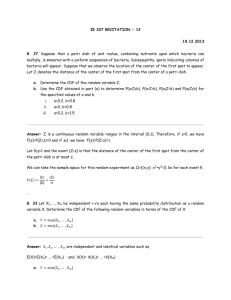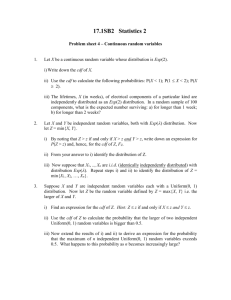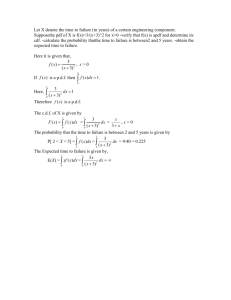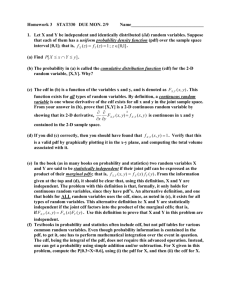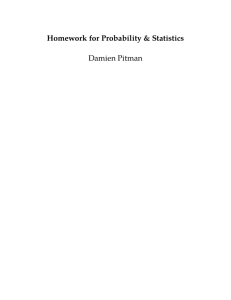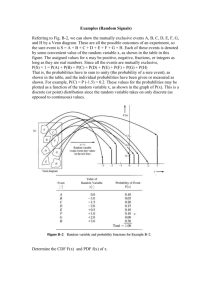Chapter5
advertisement
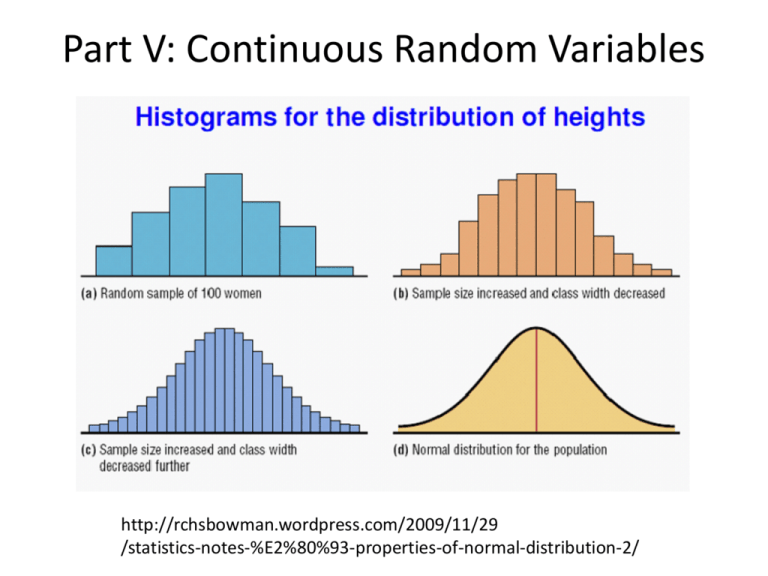
Part V: Continuous Random Variables http://rchsbowman.wordpress.com/2009/11/29 /statistics-notes-%E2%80%93-properties-of-normal-distribution-2/ Chapter 23: Probability Density Functions http://divisbyzero.com/2009/12/02 /an-applet-illustrating-a-continuous-nowhere-differentiable-function// Comparison of Discrete vs. Continuous (Examples) Discrete Continuous Counting: defects, hits, die Lifetimes, waiting times, values, coin heads/tails, height, weight, length, people, card proportions, areas, arrangements, trials until volumes, physical success, etc. quantities, etc. Comparison of mass vs. density Mass (probability mass function, PMF) 0 ≤ pX(x) ≤ 1 Density (probability density function, PDF) 0 ≤ fX(x) ∞ 𝑝𝑋 𝑥 = 1 𝑥 𝑓𝑋 𝑥 𝑑𝑥 = 1 −∞ P(0 ≤ X ≤ 2) = P(X = 0) 𝑃 0 ≤ 𝑋 ≤ 2 = + P(X = 1) + P(X = 2) P(X ≤ 3) ≠ P(X < 3) when P(X = 3) ≠ 0 2 𝑓𝑋 𝑥 𝑑𝑥 0 P(X ≤ 3) = P(X < 3) since P(X = 3) = 0 always Example 1 (class) Let x be a continuous random variable with density: 1 𝑓𝑋 𝑥 = 24 2𝑥 + 3 1 ≤ 𝑥 ≤ 4 0 𝑒𝑙𝑠𝑒 a) What is P(0 ≤ X ≤ 3)? b) Determine the CDF. c) Graph the density. d) Graph the CDF. e) Using the CDF, calculate P(0 ≤ X ≤ 3), P(2.5 ≤ X ≤ 3) Example 1 (cont.) 1 f(x) 0.8 0.6 0.4 0.2 0 0 1 2 3 4 5 1 x 0.8 F(x) -1 0.6 0.4 0.2 0 -1 0 1 2 x 3 4 5 Example 2 Let X be a continuous function with CDF as follows 0 𝑥<0 𝐹𝑋 𝑥 = 𝑥 2 0 ≤ 𝑥 ≤ 1 1 1<𝑥 What is the density? Comparison of CDFs Function Discrete Continuous 𝐹𝑋 𝑎 = 𝑃 𝑋 ≤ 𝑎 𝐹𝑋 𝑎 = 𝑃 𝑋 ≤ 𝑎 = = 𝑃(𝑋 = 𝑎) 𝑥≤𝑎 graph graph Step function with jumps of the same size as the mass Range: 0 ≤ X ≤ 1 𝑎 𝑓𝑋 𝑥 𝑑𝑥 −∞ continuous Range: 0 ≤ X ≤ 1 Example 3 Suppose a random variable X has a density given by: 4 𝑘𝑥 0 < 𝑥 < 4 𝑓𝑋 𝑥 = 0 𝑒𝑙𝑠𝑒 Find the constant k so that this function is a valid density. Example 4 Suppose a random variable X has the following density: 1 0<𝑥<1 2 𝑓𝑋 𝑥 = 1 1≤𝑥≤4 6 0 𝑒𝑙𝑠𝑒 a) Find the CDF. b) Graph the density. c) Graph the CDF. -1 1 0.8 0.6 0.4 0.2 0 0 1 2 3 4 5 x 1 0.8 F(x) f(x) Example 4 (cont.) 0.6 0.4 0.2 0 -1 0 1 2 x 3 4 5 Mixed R.V. – CDF Let X denote a number selected at random from the interval (0,4), and let Y = min(X,3). Obtain the CDF of the random variable Y. 1 0.8 0.6 0.4 0.2 0 -1 0 1 2 3 4 Chapter 24: Joint Densities http://www.alexfb.com/cgi-bin/twiki/view/PtPhysics/WebHome Probability for two continuous r.v. http://tutorial.math.lamar.edu/Classes/CalcIII/DoubleIntegrals.aspx Example 1 (class) A man invites his fiancée to a fine hotel for a Sunday brunch. They decide to meet in the lobby of the hotel between 11:30 am and 12 noon. If they arrive a random times during this period, what is the probability that they will meet within 10 minutes? (Hint: do this geometrically) Example: FPF (Cont) 40 30 20 10 0 -10 0 -10 10 20 30 40 Example 2 (class) Consider two electrical components, A and B, with respective lifetimes X and Y. Assume that a joint PDF of X and Y is fX,Y(x,y) = 10e-(2x+5y), x, y > 0 and fX,Y(x,y) = 0 otherwise. a) Verify that this is a legitimate density. b) What is the probability that A lasts less than 2 and B lasts less than 3? c) Determine the joint CDF. d) Determine the probability that both components are functioning at time t. e) Determine the probability that A is the first to fail. f) Determine the probability that B is the first to fail. Example 2d t t Example 2e y=x Example 2e y=x Example 3 Suppose a random variables X and Y have a joint density given by: 𝑘𝑥𝑦 0 < 𝑥, 𝑦 < 2 𝑓𝑋,𝑌 𝑥, 𝑦 = 0 𝑒𝑙𝑠𝑒 Find the constant k so that this function is a valid density. Example 4 (class) Suppose a random variables X and Y have a joint density given by: 𝑥 + 𝑦 0 < 𝑥, 𝑦 < 1 𝑓𝑋,𝑌 𝑥, 𝑦 = 0 𝑒𝑙𝑠𝑒 a) Verify that this is a valid joint density. b) Find the joint CDF. c) From the joint CDF calculated in a), determine the density (which should be what is given above). Example: Marginal density (class) A bank operates both a drive-up facility and a walk-up window. On a randomly selected day, let X = the proportion of time that the drive-up facility is in use (at least one customer is being served or waiting to be served) and Y = the proportion of time that the walk-up window is in use. The joint PDF is 6 2 (x y ) 0 x 1,0 y 1 fX,Y (x,y) 5 0 else a) What is fX(x)? b) What is fY(y)? Example: Marginal density (homework) A nut company markets cans of deluxe mixed nuts containing almonds, cashews and peanuts. Suppose the net weight of each can is exactly 1 lb, but the weight contribution of each type of nut is random. Because the three weights sum to 1, a joint probability model for any two gives all necessary information about the weight of the third type. Let X = the weight of almonds in a selected can and Y = the weight of cashews. The joint PDF is 24xy 0 x 1,0 y 1,x y 1 fX ,Y (x,y) else 0 a) What is fX(x)? b) What is fY(y)? Chapter 25: Independent Why’s everything got to be so intense with me? I’m trying to handle all this unpredictability In all probability -- Long Shot, sung by Kelly Clarkson, from the album All I ever Wanted; song written by Katy Perry, Glen Ballard, Matt Thiessen Example: Independent R.V.’s A bank operates both a drive-up facility and a walk-up window. On a randomly selected day, let X = the proportion of time that the drive-up facility is in use (at least one customer is being served or waiting to be served) and Y = the proportion of time that the walk-up window is in use. The joint PDF is 6 2 (x y ) 0 x 1,0 y 1 fX,Y (x,y) 5 0 else 6 2 3 6 2 𝑓𝑋 𝑥 = 𝑥 + , 𝑓𝑌 𝑦 = + 𝑦 5 5 5 5 Are X and Y independent? Example: Independence Consider two electrical components, A and B, with respective lifetimes X and Y with marginal shown densities below which are independent of each other. fX(x) = 2e-2x, x > 0, fY(y) = 5e-5y, y > 0 and fX(x) = fY(y) = 0 otherwise. What is fX,Y(x,y)? Example: Independent R.V.’s (homework) A nut company markets cans of deluxe mixed nuts containing almonds, cashews and peanuts. Suppose the net weight of each can is exactly 1 lb, but the weight contribution of each type of nut is random. Because the three weights sum to 1, a joint probability model for any two gives all necessary information about the weight of the third type. Let X = the weight of almonds in a selected can and Y = the weight of cashews. The joint PDF is 24xy 0 x 1,0 y 1,x y 1 fX ,Y (x,y) else 0 Are X and Y independent? Chapter 26: Conditional Distributions Q : What is conditional probability? A : maybe, maybe not. http://www.goodreads.com/book/show/4914583-f-in-exams Example: Conditional PDF (class) Suppose a random variables X and Y have a joint density given by: 𝑥 + 𝑦 0 < 𝑥, 𝑦 < 1 𝑓𝑋,𝑌 𝑥, 𝑦 = 0 𝑒𝑙𝑠𝑒 a) Calculate the conditional density of X when Y = y where 0 < y < 1. b) Verify that this function is a density. c) What is the conditional probability that X is between -1 and 0.5 when we know that Y = 0.6. d) Are X and Y independent? (Show using conditional densities.) Chapter 27: Expected values http://www.qualitydigest.com/inside/quality-insider-article /problems-skewness-and-kurtosis-part-one.html# Comparison of Expected Values Discrete Continuous ∞ 𝔼 𝑋 = 𝑥𝑝𝑋 (𝑥) 𝑥 𝔼 𝑋 = 𝑥𝑓𝑋 𝑥 𝑑𝑥 −∞ Example: Expected Value (class) What is the expected value in each of the following situations: a) The following is the density of the magnitude X of a dynamic load on a bridge (in newtons) 1 3 x 0x2 fX (x) 8 8 0 else b) The train to Chicago leaves Lafayette at a random time between 8 am and 8:30 am. Let X be the departure time. 2 8 x 8.5 fX (x) else 0 Chapter 28: Functions, Variance http://quantivity.wordpress.com/2011/05/02/empirical-distribution-minimum-variance/ Comparison of Functions, Variances Discrete Function (general) Continuous 𝔼 𝑔(𝑋) 𝔼 𝑔(𝑋) = = ∞ 𝑔(𝑥)𝑝𝑋 (𝑥) −∞ 𝑥 Function 2 = 𝔼 𝑋 (X2) 𝑔(𝑥)𝑓𝑋 𝑥 𝑑𝑥 ∞ 𝑥 2 𝑝𝑋 (𝑥) 𝔼 𝑋 2 = 𝑥 2 𝑓𝑋 𝑥 𝑑𝑥 −∞ 𝑥 Variance Var(X) = 𝔼(X2) – (𝔼(X))2 Var(X) = 𝔼(X2) – (𝔼(X))2 SD 𝜎𝑋 = 𝑉𝑎𝑟(𝑋) 𝜎𝑋 = 𝑉𝑎𝑟(𝑋) Example: Expected Value - function (class) What is 𝔼(X2) in each of the following situations: a) The following is the density of the magnitude X of a dynamic load on a bridge (in newtons) 1 3 x 0x2 fX (x) 8 8 0 else b) The train to Chicago leaves Lafayette at a random time between 8 am and 8:30 am. Let X be the departure time. 2 8 x 8.5 fX (x) else 0 Example: Variance (class) What is the variance in each of the following situations: a) The following is the density of the magnitude X of a dynamic load on a bridge (in newtons) 1 3 x 0x2 fX (x) 8 8 0 else b) The train to Chicago leaves Lafayette at a random time between 8 am and 8:30 am. Let X be the departure time. 2 8 x 8.5 fX (x) else 0 Friendly Facts about Continuous Random Variables - 1 • Theorem 28.18: Expected value of a linear sum of two or more continuous random variables: 𝔼(a1X1 + … + anXn) = a1𝔼(X1) + … + an𝔼(Xn) • Theorem 28.19: Expected value of the product of functions of independent continuous random variables: 𝔼(g(X)h(Y)) = 𝔼(g(X))𝔼(h(Y)) Friendly Facts about Continuous Random Variables - 2 • Theorem 28.21: Variances of a linear sum of two or more independent continuous random variables: Var(a1X1 + … + anXn) =𝑎12 Var(X1) + … + 𝑎𝑛2 Var(Xn) • Corollary 28.22: Variance of a linear function of continuous random variables: Var(aX + b) = a2Var(X) Chapter 29: Summary and Review http://www.ux1.eiu.edu/~cfadd/1150/14Thermo/work.html Example: percentile Let x be a continuous random variable with density: 1 𝑓𝑋 𝑥 = 24 2𝑥 + 3 1 ≤ 𝑥 ≤ 4 0 𝑒𝑙𝑠𝑒 0 𝑥<1 1 2 𝐹𝑋 𝑥 = 𝑥 + 3𝑥 − 4 1 ≤ 𝑥 ≤ 4 24 1 4<𝑥 a) What is the 99th percentile? b) What is the median?

